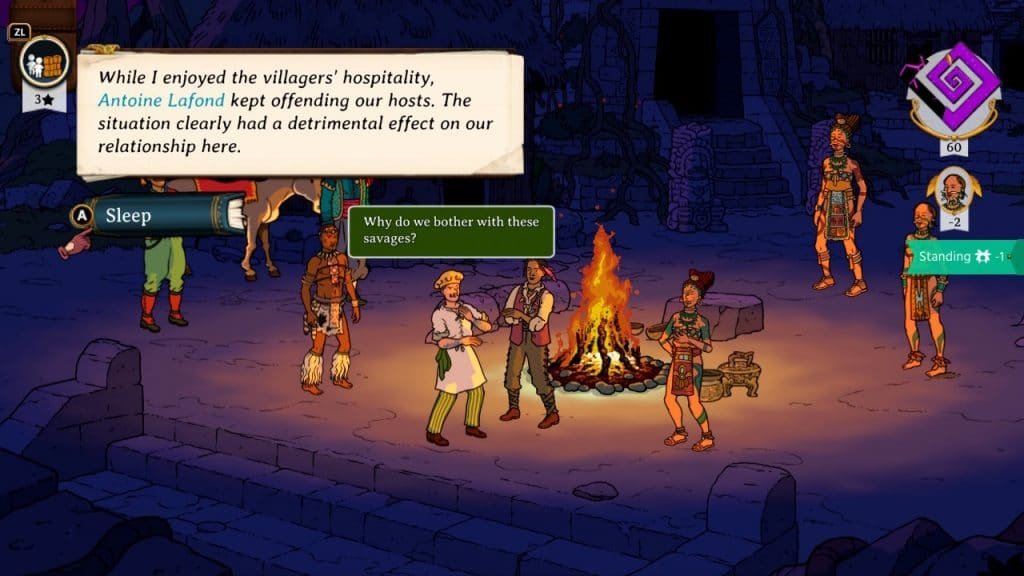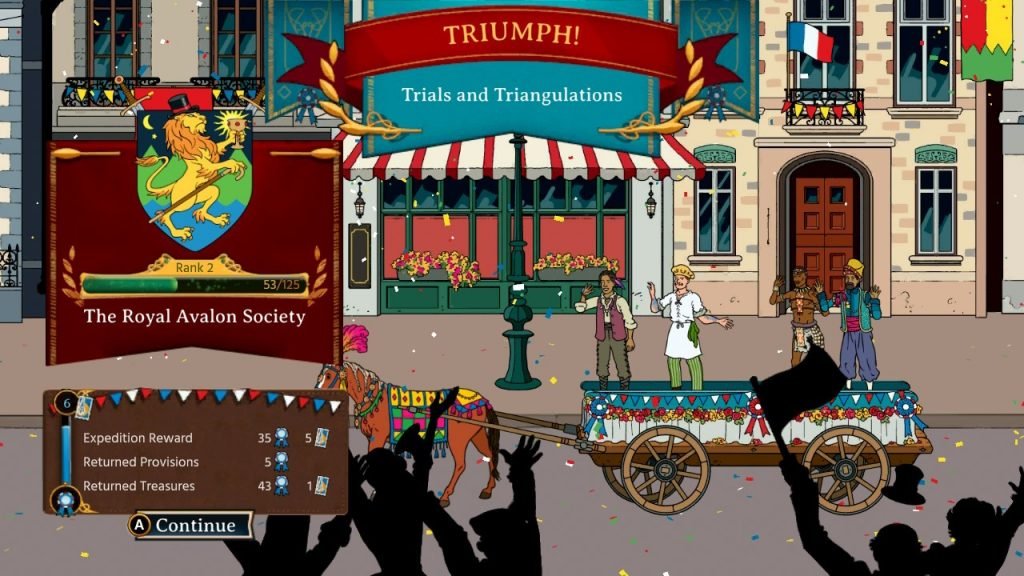Quick View
Game: Curious Expedition 2
Release Date: August 11, 2021
Price: $19.99
Rating: Teen
Platform: Switch, Windows (PlayStation and Xbox coming soon)
Geek to Geek Media was provided with a review copy of this title.
Curious Expedition 2 intrigued me when I first saw it thanks to its Tin-Tin-esque art style and the pitch of a narrative roguelike game. Having spent a bit of time with it now, I've found it to be a really interesting experience that's more interactive than any visual novel I've played, but also more passive than just about any game outside of that genre. There are three main phases in Curious Expedition 2; a general preparation phase, a specific prep phase for the adventure you're embarking on, and then the adventure itself. Throughout the game, you repeat this loop over and over again to uncover little pieces of a bigger mystery.
Preparing for Adventure

Curious Adventure 2 puts you into the shoes of a high society explorer. So, unlike games like Spelunky, your quest doesn't start in a dingy cave. Instead, the first steps towards adventure are on a balcony overlooking the Eiffel Tower. Throughout the game, you'll find more contacts within Paris, whom you visit between adventures. As you gain renown and currency with different organizations, you can visit them to purchase new gear to help you on your quests.

Naturally, there's also a local drinking establishment to visit. Trips here during the day give you an opportunity to change the difficulty level for your game. There are actually two settings here, one for general difficulty and one for how punishing death is. Being able to do this within the game itself is really nice, but I started and stuck with the default settings for my time. Hardcore players can play a super punishing version with permadeath if they really want that classic rogue experience.
The other big reason to visit the Tavern is to recruit new members to your adventuring party. The start of the game has you choosing a character class to be your leader, who comes with two other characters. Between each adventure, you can stop in at the Tavern to get a selection of new characters to choose from. My favorites so far have been Mr. Thurman, a donkey who makes travel a bit easier and also has a mean kick, and Antoine Lafond, an imperialist, racist, awful human being of a chef whose character arc has become my favorite part of the game. More on him later.
Setting Off on Adventure

Once you've perused the Parisian promenade, it's time to get your adventure started. Curious Expedition 2 is broken up into years, and each year is broken up into a few expeditions. After doing a few default expeditions to gather information about the mysterious islands you're exploring, you end the year with a longer story mission that moves the overall plot forward.
At the start of standard adventures, you get to choose between two or three different objectives, each with its own difficulty and reward. There's not a lot of info to pick from here, so you'll basically feel like Quark picking a route in Chulah: “Double their peril, double your winnings!”

You also get to pick out an explorer club to sponsor your journey. There are three organizations all looking to bring back discoveries from your journey. One is focused on pure exploration, one on mysticism, and one on technology. Each of these groups has its own shop in Paris, and the more expeditions you undertake in their name, the more access you get to their wares.
Finally, your crew will spend one last night at the bar before setting off. This is accompanied by a random story beat. I've met NPCs in the bar who popped up later on, or ones who will join me for my journey. Once the bar was overcrowded and understaffed, and I asked _ to help out for the evening. He ended up walking away with some extra experience points and, I hope, an appreciation for what it's like to work the front of the house.
Curious Expedition 2 is all about the Journey

Each adventure in Curious Expedition 2 starts with your adventuring party arriving on an island shrouded in mystery. For the player, this means a pretty basic “fog of war” mechanic. Only a few hexagonal tiles around your party are revealed to you. As you set a course and venture out across the island, more and more of the fog dissipates, revealing different terrains, animals, locations, and other objects of interest. This part of the game reminds me a lot of Sid Meier's Civilization games, except that you never build anything.

Before you can actually interact with the latest shrine or rampaging elephant that you've spotted, your party has to actually get to that destination. Every move that you make on the map board takes up some amount of your party's “sanity”, represented by a purple meter in the top right corner of your screen. You can refill this meter by resting at safe locations on the map that are few and far between or by eating food you've carried with you. As that meter gets closer to empty you become more likely to run into random events that can cause all sorts of negative side effects to your party.
Just imagine what could happen if your uppity French chef (who is at least a bit xenophobic already) started to starve in the middle of a jungle while having to share the last hyena steak with an indigenous shaman.
Rolling Dice

Once you get to an interaction point on the map, Curious Expedition 2 switches to a simply illustrated side view of the interaction. Whether you're meeting a tribal chief or stalking a wild beast or even battling raging scorpions, dice determine the outcome of everything. Each and every character in your party comes with one or more six-sided dice. Each side of the cube can either be blank or adorned with a red, blue, or green symbol, each color basically representing different attributes, basically action, intelligence, and guile respectively. The number and type of dice you have with you depends on your characters' skill, levels, and equipment.

The game does a great job of showing you how your dice match up with the challenge without giving you a success percentage. It would be a lot simpler to read if it did, but I think that'd take away from the feel of sizing up your party against the obstacles that you are facing. There are even some items you can carry with you that will add extra dice to these rolls, so figuring out when to use those is an important part of the overall strategy. I ended up really liking the social interactions a lot, even when the dice rolled against me.
Turn-Based Combat with a Twist

Combat encounters in Curious Expedition 2 use those same dice just a bit differently. On your turn, all of your characters roll out their dice, and each symbol represents a different ability they can use that turn. There are attacks, buffs and debuffs, and healing abilities; everything you'd expect in any turn-based game. Two twists based on the dice mechanics make this combat stand out for me. First of all, a lot of your abilities can be enhanced by adding additional dice to them. As an example, Mr. Thurman the donkey's kick can do bonus damage if he “borrows” a red die from another character. Secondly, each turn you can choose to grab as many of your dice as you'd like to reroll them.
For a while, my basic strategy mechanic was to get Mr. Thurman's kick available, then use a debuff ability to make the enemy more vulnerable and a buff ability to make Mr. Thurman stronger. Once he was all juiced up and the enemy was low on defense, I'd have Mr. Thurman borrow as many red dice as he could to deliver a kick that would strike fear in the hearts of gods and men.
Controller Controls
Talking about combat does lead me to my one big complaint against the interface in Curious Expedition 2. Throughout the game, there is always a lot going on on-screen. Most of the time, the various points of interaction are labeled well enough that I didn't get too stuck trying to make something happen. However, in combat, there's a huge issue. At the start of an encounter, you press the plus button on the Switch controller to roll your first set of dice. Then, say you want to reroll some of them. You might, being me, press the plus button again to initiate rolling. Unfortunately, once you've hit the plus button once to actually start the combat that button becomes the end turn button. I ended up skipping my first turn of almost every encounter by ending my turn when I meant to roll my dice.
The Curious Case of Antoine Lafond

Okay, it's time for me to talk about Antoine Lafond. This cook became a huge asset to my party when I realized that he could cook raw meat I recovered from attacked animals. Since this greatly increased how much sanity meat recovered, he was invaluable. However, this dude was also a racist, imperialist dirtbag who was constantly costing me the respect of locals and arguing with Xelugu, a shaman in our party.
Given the randomized nature of just about everything in Curious Expedition 2, I was at a loss about what to do with this guy. I didn't know if there was some way to change his behavior, so I was just kind of stuck with him for the longest time.

Antoine caused tension at just about every story interval of the game, until one fateful rest stop. I don't know how it happened or why, but a conversation was triggered between Antoine and Xelugu where the French chef admitted begrudging respect for the Shaman's people. First I was surprised, and then I bust up laughing when a box popped up saying “Antoine Lafond: – Imperialism”.
Yup, that was it. I don't know why, but for some reason, he suddenly had the “Imperialism” tag removed from his character sheet.

Since then, it's been a lot more pleasant having Antoine Lafond along on my journeys. Now, don't get me wrong, he's still an uppity jerk who has a tag for hating Xelugu, but at least he doesn't offend the hosts every time we stay in a village.
Final Thoughts

Curious Expedition 2 mixes the narrative drive of a visual novel with the emergent storytelling of a procedural rogue-like and dice-based mechanics to create an experience that is absolutely captivating. My ADHD struggles with playing a game that I can't listen to a podcast during, but I got so into exploring this world that it pulled me past that.
I know that I have barely scratched the surface of this game, and I'm excited to keep working my way through it. If nothing else, this is a great game to play for a half-hour or so before you go to sleep for the night, because it ends up feeling like a book that you get to be a part of. It doesn’t hurt that it looks great, too!


[…] Exploration, Adventure, and Bullet Hell […]
[…] life, Exploration, Sad […]
[…] Focus, Rolling Dice, and Sad […]